激光选择熔化成形工艺参数对多孔钛结构的影响及成孔机理
[1] Oh IH, Nomura N, Masahashi N, et al.. Mechanical properties of porous titanium compacts prepared by powder sintering[J]. Scripta Materialia, 2003, 49(12): 1197-1202.
[2] Tamai N, Myoui A, Tomita T, et al.. Novel hydroxyapatite ceramics with an inter connective porous structure exhibit superior osteoconduction in vivo[J]. J Biomed Mater Res, 2002, 59(1): 110-117.
[3] Simske S J, Ayers R A, Bateman T A. Porous materials for bone engineering[J]. Materials Science Forum, 1997, 250: 151-182.
[4] Oh IH, Nomura N, Hanada S. Microstructures and mechanical properties of porous titanium compacts prepared by powder sintering[J]. Materials Transactions, 2002, 43(3): 443-446.
[5] Galante J, Rostoker W, Lueck R. Sintered fibre metal composites as a basis for attachment of implants to bone[J]. J Bone Joint Surg Am, 1971, 53(1): 101-114.
[6] 李虎, 虞奇峰, 张波, 等. 浆料发泡法制备生物活性多孔钛及其性能[J]. 稀有金属材料与工程, 2006, 35(1): 154-157.
Li Hu, Yu Qifeng, Zhang Bo, et al.. Fabrication and characterization of bioactive porous titanium[J]. Rare Metal Materials and Engineering, 2006, 35(1): 154-157.
[7] 陈存敬, 郭志猛, 贾成厂, 等. 自蔓延高温合成Ti-Ni多孔体合金[J]. 粉末冶金技术, 2003, 21(3): 135-139.
Chen Cunjing, Guo Zhimeng, Jia Chengchang, et al.. Ti-Ni porous alloys prepared by SHS process[J]. Powder Metallurgy Technology, 2003, 21(3): 135-139.
[8] 吴伟辉, 杨永强, 王迪, 等. 选区激光熔化变密度快速制造工艺研究[J]. 中国激光, 2010, 37(7): 1879-1884.
[9] 杨永强, 何兴荣, 吴伟辉, 等. 选区激光熔化直接成型个性化骨科手术模板[J]. 中国激光, 2009, 36(9): 2460-2464.
[10] 付立定. 不锈钢粉末选择性激光熔化直接制造金属零件研究[D]. 武汉: 华中科技大学, 2008. 15-21.
Fu Liding. Investigation Into Manufacturing Metal Parts Direct From Stainless Steel Powders via Selective Laser Melting[D]. Wuhan: Huazhong University of Science & Technology, 2008. 15-21.
[11] 王志阳. 选区激光熔化制备多孔316L不锈钢和多孔钛的研究[D]. 南京: 南京航空航天大学, 2010. 19-21.
Wang Zhiyang. Preparation of Porous 316L Stainless Steel and Porous Titanium by Selective Laser Melting[D]. Nanjing: Nanjing University of Aeronautics and Astronautics, 2010. 19-21.
[12] Wang Y, Shen Y F, Wang Z Y, et al.. Development of highly porous titanium scaffolds by selective laser melting[J]. Materials Letters, 2010, 64(6): 674-676.
[13] 陈长军, 张敏. 多孔钽的制备方法及装置[P], 中国专利: 201110395892.6. 2012-04-11.
Chen Changjun, Zhang Min. The Preparation Method and Device of Porous Tantalum[P], China Patent: 201110395892.6. 2012-04-11.
[14] 王燕. 选区激光烧结制备多孔Ni基合金的显微组织及其冶金机理[D]. 南京: 南京航空航天大学, 2011. 34-37.
Wang Yan. Microstructural Features and Metallurgical Mechanisms of Porous Nickel-Based Alloy Prepared by Selective laser Sintering[D]. Nanjing: Nanjing University of Aeronautics and Astronautics, 2011. 34-37.
[15] Fischer P, Romano V, Weber H P, et al.. Sintering of commercially pure titanium powder with a NdYAG laser source[J]. Acta Materialia, 2003, 51(6): 1651-1662.
[16] K Anselme. Osteoblast adhesion on biomaterial[J]. Biomaterials, 2000, 21(7): 667-681.
张超, 陈长军, 王晓南, 张敏, 敬和民. 激光选择熔化成形工艺参数对多孔钛结构的影响及成孔机理[J]. 中国激光, 2013, 40(s1): s103003. Zhang Chao, Chen Changjun, Wang Xiaonan, Zhang Min, Jing Hemin. Effect of Process Parameters on Porous Titanium Structure and Mechanism of Porous Formation in Selective Laser Melting[J]. Chinese Journal of Lasers, 2013, 40(s1): s103003.





